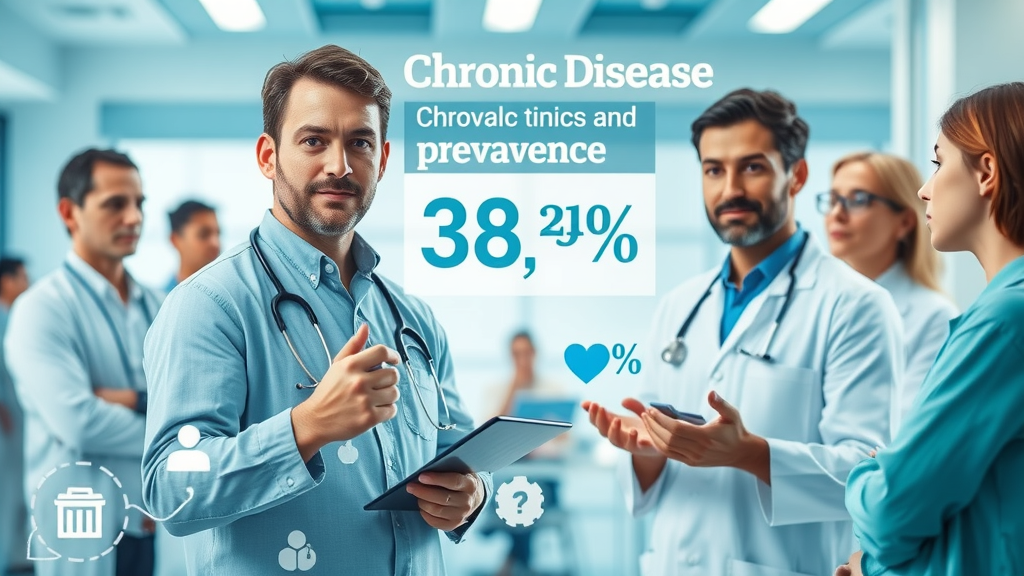Did you know that one in three adults is living with a chronic disease? This staggering reality means that nearly every family is touched by long-term health conditions—yet most people underestimate the transformative power of proactive chronic disease management . Whether you or a loved one are facing heart disease, diabetes, or another persistent health challenge, the right management strategies can dramatically improve daily life, boost well-being, and even prolong your years. Read on to discover proven ways to take charge of your health and thrive, no matter where you or your loved ones are on the journey.
One in Three Adults Have a Chronic Disease: Why Chronic Disease Management Matters Now
- Chronic disease management is essential for millions, yet many people underestimate how overwhelmingly these conditions shape lives. The impact goes far beyond physical symptoms—it affects families, daily routines, finances, and emotional health. But by recognizing the scale of chronic disease prevalence— one in every three adults —we can understand just how vital disease management is, not only at the personal level, but as a major public health imperative.
- With improved disease management approaches, people experience fewer complications, retain independence longer, and report a higher quality of life. In the United States, over half of all adults live with at least one chronic health condition, further emphasizing the need for individuals and communities to prioritize management strategies. This article will equip you with the knowledge and confidence to take control of chronic diseases for yourself or your loved ones.

How This Guide Empowers Your Chronic Disease Management Journey
- This comprehensive guide is designed to provide you with up-to-date, actionable chronic disease management strategies. We’ll break down the latest research, highlight innovative management programs, and guide you through integrating physical activity and healthy behaviors into your life. You’ll explore the important connection between mental health and chronic disease, giving you the well-rounded perspective needed for lasting improvements.
- Whether you’re newly diagnosed or seeking better ways to manage longstanding conditions, you’ll find practical advice and resources within these pages. This guide will help you understand the options available, empower you to become an active participant in your care, and support you in building habits that make a genuine difference every day.
What You’ll Gain from Mastering Chronic Disease Management
- Understand the fundamentals and importance of chronic disease management
- Identify effective disease management strategies for chronic diseases
- Explore management programs and their effectiveness
- Gain tips for integrating healthy behaviors like physical activity
- Recognize public health implications and lasting benefits
What is Chronic Disease Management? Key Principles Explained
Definitions and Types of Chronic Diseases Requiring Management
- The terms chronic disease and chronic condition are often used interchangeably, but it’s helpful to understand their distinctions. Chronic diseases refer to ongoing health issues that tend to last a year or more and require ongoing medical attention, including heart disease , diabetes, arthritis, and certain respiratory conditions. Chronic conditions can include not just diseases, but also disorders and syndromes—like hypertension, asthma, or autoimmune disorders—that demand ongoing care or lifestyle adjustments.
- Major chronic diseases —such as heart disease , type 2 diabetes, and arthritis—are the leading causes of disability and death in the United States. What sets them apart is not just their duration, but their profound effect on daily life and the necessity for lifelong vigilance and care.
- Effective chronic disease management is not a one-off task—it’s a lifelong process. Success depends on continual self-care, regular monitoring, and strong collaboration with health care professionals and community resources.

Medical Management of Chronic Disease: A Multidisciplinary Process
- Optimal disease management is rarely a solo journey. Instead, it’s a collaborative process involving doctors, nurses, pharmacists, and allied health care professionals who tailor treatment to your needs. Their roles range from prescribing medications and tracking your progress, to coordinating care and providing ongoing education.
- Successful chronic disease management includes medication adherence, routine monitoring of symptoms or biomarkers, and giving patients the knowledge to make informed choices. Tools like digital apps for tracking health data and telehealth check-ins with your care provider are increasingly standard.
- The relationship you develop with your medical team should be one of continuous support, with a focus on long-term, patient-centered care. This approach not only makes it easier to manage daily symptoms, but significantly boosts long-term health outcomes and quality of life.
“Effective chronic disease management is not about curing, but about empowering people to live well with their conditions.” – World Health Organization
Proven Strategies for Chronic Disease Management: Putting Knowledge into Practice
Creating an Individualized Chronic Disease Management Program
- Every person’s health journey is unique. That’s why creating a personalized management program starts with an honest assessment of your specific needs, risks, and lifestyle. Your care provider can help identify challenges, whether it’s managing medication side effects, fitting physical activity into your schedule, or addressing hurdles with access to healthy foods.
- Customizing your disease management plan may include enlisting a nutritionist, using health apps for tracking, or joining a support group. Digital tools and wearables can track blood pressure, glucose, or activity—helping you and your medical team adjust the management strategy as needed.
- Remember, your program should evolve over time. As your goals, health, and circumstances change, regular check-ins with your care team help ensure your management plan always fits your reality.

Incorporating Physical Activity into Disease Management Programs
- Decades of research confirm that regular, moderate physical activity is vital for controlling many chronic diseases. For conditions such as heart disease , diabetes, and arthritis, engaging in walking, swimming, strength training, or gentle yoga can reduce symptoms, lower medication needs, and reduce hospitalizations.
- It’s important to follow guidelines tailored to your specific condition. Most chronic disease management programs recommend at least 150 minutes a week of moderate exercise, ideally approved by your health care team. Start slowly and adjust intensity as you build endurance.
- For example, a recent study showed that patients with heart disease who walked for 30 minutes, five days a week had improved cardiovascular function and saw a drop in heart failure admissions. Safe and enjoyable physical activity is a cornerstone of effective chronic disease management.

Nutrition and Chronic Disease Management: Fueling Health Care from the Inside Out
- Diet plays a pivotal role in managing chronic diseases like diabetes and heart disease. For instance, eating plenty of fruits, vegetables, lean proteins, and whole grains helps control blood sugar, reduces inflammation, and lowers heart disease risk. Limiting saturated fats, sugars, and excess sodium is equally important.
- Regular meal planning makes healthy eating sustainable. Use tools or apps for recipe inspiration and grocery lists. Sample nutritious, chronic-disease-friendly recipes include oatmeal with berries for breakfast, grilled salmon with quinoa for lunch, and roasted vegetables for dinner—each packed with fiber and antioxidants for strong health outcomes.
- Collaboration with your health care team or a registered dietitian can further personalize your plan. They can offer specialized advice and ongoing encouragement, making it easier to adapt to your evolving health needs and preferences.

Stress, Mental Health, and Their Impact on Chronic Diseases
- Chronic conditions don’t only challenge your body—they impact your mind. Recognizing the psychological weight of living with ongoing health issues is a vital first step in comprehensive disease management . Studies have linked chronic diseases with increased rates of anxiety and depression, underscoring the need for holistic support.
- Science-backed stress management techniques—such as mindfulness meditation, deep breathing, or therapy—can improve both mood and physical health outcomes. Regularly practicing these skills helps reduce stress hormones, support immune function, and enhance resilience.
- Building a strong support network is equally crucial. Whether you join a local support group, seek counseling, or participate in community programs, these connections improve not just emotional health, but also the ability to stick with challenging lifestyle changes for the long term.

Comparing Disease Management Programs: What Works Best?
| Program Type | Key Features | Best For | Support |
|---|---|---|---|
| Hospital-Based Management Programs | Specialist oversight, medication optimization, structured rehab | Advanced or complex chronic conditions | Doctors, nurses, pharmacists |
| Community-Based Programs | Peer support, group education, public health outreach | General chronic disease maintenance, early intervention | Community health workers, support groups |
| Digital/Telehealth Programs | Remote monitoring, virtual consults, app-based tracking | People with limited mobility or rural access | Telehealth staff, remote medical teams |
Evaluating Popular Chronic Disease Management Programs
- In-hospital management programs provide intensive, individualized care, especially for people with complex chronic diseases like severe heart failure or uncontrolled diabetes. They offer comprehensive monitoring, medication adjustment, and direct, multidisciplinary support. On the other hand, community-based programs foster long-term habit change through group education, peer-led activities, and local outreach, making them indispensable for widespread public health improvement.
- The rapid rise of telehealth has transformed access to care, allowing patients to connect with their care providers regardless of physical location. From digital symptom tracking to secure video appointments, these solutions bridge gaps for those living in rural or underserved communities.
- Ultimately, the most successful management program is the one that fits your lifestyle, values, and health needs. Public health strategies encourage scaling up what works locally, such as community education and preventive screening, to support the greatest number of people.
"A management program that fits your lifestyle can reduce hospitalizations and give you control over your health journey."
Chronic Disease Management and Public Health: A Broader Perspective
Public Health Initiatives Advancing Chronic Disease Management
- Strong government policies —such as broader insurance coverage for management programs, and funding for community clinics—play a major role in making chronic disease management accessible to all. For example, the Centers for Disease Control and Prevention (CDC) funds local initiatives that boost education and early intervention.
- Community-based education increases awareness about chronic diseases and empowers individuals with the knowledge to take actionable steps. Outreach programs, local health fairs, and support groups all contribute significantly to disease control.
- The most effective public health approaches prioritize preventive care . By promoting early screening, vaccination, and lifestyle modifications, public health systems help reduce new cases and prevent complications in those already living with chronic disease.

Three Ways of Managing Chronic Diseases: A Practical Guide
- Medical interventions —such as medications, surgery, or specialized therapies—are often necessary to control symptoms and prevent complications in chronic diseases like diabetes or heart failure.
- Lifestyle and behavioral modifications —regular physical activity, improved nutrition, limiting alcohol or tobacco, and managing stress—have a dramatic effect on health outcomes and are just as important as medical therapy.
- Support and education —including counseling, peer groups, and ongoing education—equip individuals to manage their chronic condition with resilience and confidence, offering tools for long-term success.
The 5 C's of Chronic Disease: Elements Every Management Program Needs
- Comprehensive care : integrating physical, mental, and social health
- Continuity : long-term strategies and follow-up
- Coordination : seamless collaboration between health care providers
- Communication : open, ongoing dialogue with your care team
- Collaboration : involvement of family, support networks, and community
"A chronic disease management plan is most effective when built on the 5 C's: Comprehensive care, Continuity, Coordination, Communication, and Collaboration."
Chronic Disease Management Program: What Is It and Who Benefits?
- A chronic disease management program is a structured system that helps patients manage long-term health conditions through coordinated care, education, and regular monitoring. These programs rely on a multidisciplinary approach, engaging doctors, nurses, health coaches, and sometimes social workers, to build a robust support network.
- Management programs improve quality of life by reducing symptoms, preventing complications, and fostering self-confidence in daily self-care. Research shows that people enrolled in such programs are less likely to be hospitalized and enjoy greater independence.
- Access is expanding. Many programs are available through hospitals, community centers, or even covered by insurance. Personalizing your own management program ensures that the unique needs of your lifestyle, health goals, and support network are all considered.

People Also Ask: Chronic Disease Management FAQs
What is the medical management of chronic disease?
- Medical management of chronic disease integrates medication, ongoing monitoring, patient education, and lifestyle interventions tailored to individual needs. By partnering with care providers , patients can effectively control symptoms, reduce risks of complications, and foster long-term health outcomes . The process is dynamic and adapts as your health changes.
What are the three ways of managing chronic diseases?
- The three primary ways are: medication and regular medical care, lifestyle modifications (including diet and physical activity ), and emotional/social support through education and engagement with community resources . All three are essential for successful, sustainable chronic disease management.
What are the 5 C's of chronic disease?
- The 5 C's of management are Comprehensive care, Continuity, Coordination, Communication, and Collaboration. These elements remain at the core of every effective chronic disease management plan.
What is the chronic disease management program?
- A chronic disease management program is an organized, structured approach that helps people with long-term conditions maintain their health, prevent complications, and optimize daily functioning. These programs offer coordinated care, education, monitoring, and supportive services, generally involving a multidisciplinary health team.
Top 10 Actionable Chronic Disease Management Tips
- Monitor your health regularly with professional guidance
- Build physical activity into your daily routine
- Adopt a nutritious, chronic-disease-friendly diet
- Create a realistic medication adherence plan
- Manage stress levels through mindfulness and support
- Set achievable, measurable health goals
- Connect with community or online support groups
- Schedule consistent health care checkups
- Use digital tools for symptom and data tracking
- Regularly review and adapt your management program

Expert Answers: Your Chronic Disease Management FAQs
What are the first steps to creating a chronic disease management program?
- Start by completing a thorough health assessment with your health care provider , set realistic goals based on your priorities, and explore available resources for ongoing education and support. Taking these steps builds a strong foundation for successful, individualized disease management .
How do I stay motivated while managing a chronic condition?
- Focus on celebrating small achievements, consistently track your progress, and seek encouragement from both peers and professionals. These strategies reinforce positive actions and build resilience, which is crucial for long-term success in managing chronic diseases.
Final Thoughts: Embracing Proven Chronic Disease Management for a Healthier Future
- By integrating these proven chronic disease management strategies into your daily routine, you hold the key to a longer, fuller, and more empowered life. Start your journey today and take control of your chronic disease with confidence.
 Add Row
Add Row  Add
Add 



Write A Comment